Apricot Farming in India with Varieties and Benefits
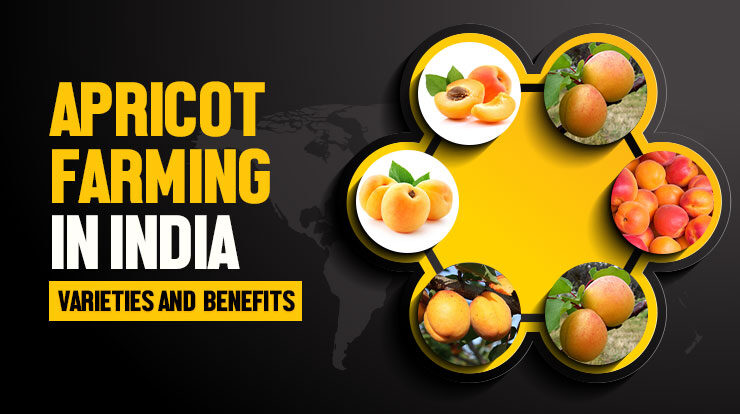
Apricot, a stone fruit, is likely tasty, sweet, tangy, but delicious in flavour. This stone fruit is commonly known as Armenian plums, mainly cultivated in apricot species. Apricots have been grown for many centuries globally. Apricot farming widely in many countries and is sometimes harvested from the wild areas. Organic dried apricots are grown by that grower who is certified and according to the standards of organic agriculture.
Apricot plants are one of the kinds of self-pollination plants, and they don’t need any partner for fertilisation. Also, it is the most popular fruit in many countries for daily cuisine. Apricot fruit plants require a small amount of water and are most suitable for mild winters. It is a Mediterranean crop, requiring summers, low humidity and dry weather to grow well.
The commercial farming of apricot is quite limited in India. However, because apricot fruits require a hilly region to grow, if you are planning to start a profitable apricot farming business, this blog will help you. In the further blog, you can read the complete information from apricot cultivation, most producing states, to starting a business.
Most Producing Regions of Apricot Fruit Globally
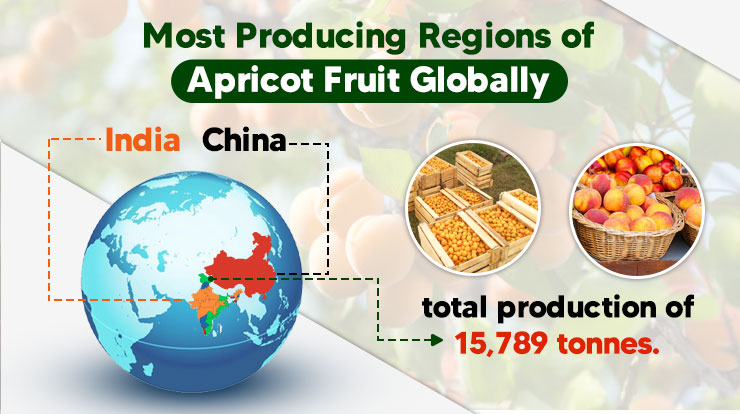
According to the Globe, Apricots are native to China, which is the biggest global country, where apricot cultivation is huge.
In India, Ladakh is the largest apricot producer, with a total production of 15,789 tonnes. After Ladakh, Himachal Pradesh and Jammu & Kashmir are India’s major apricot producing states.
Cultivation of apricot fruit is also done in Uttar Pradesh and the North-Eastern hilly region to a lesser extent.
Suitable Apricot Tree Varieties to Plant
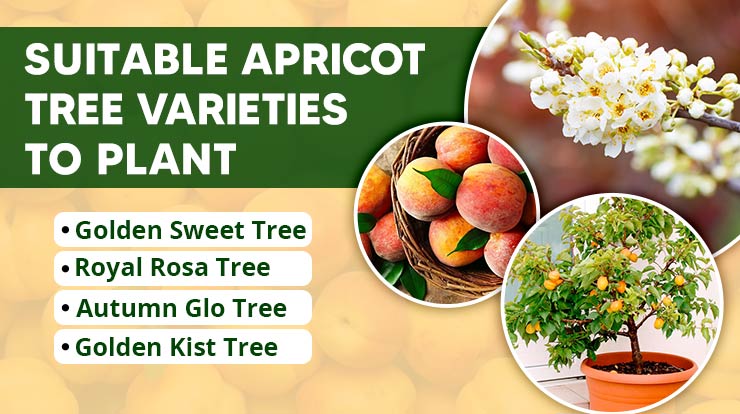
Now grow apricots in your gardens very easily with a wide range of apricot trees. Here we can assist you with the best and suitable apricot tree variety for your garden. Here we are suggesting to you the 4 apricot tree varieties, in which you can get information about apricot trees with USDA hardiness zone temperature.
1. Golden Sweet Tree
It is one of the apricot tree varieties for your home garden. The Golden Sweet Tree is very beautiful and produces tasty apricots.
USDA Hardiness Zones (Growing Temperature) – 5-8 (−23.3°C to −12.2°C)
Mature Height – 12-18 Feet
Chilling Hours – 400 to 500 hours
Weather – Cold winters.
2. Royal Rosa Tree
It is one of the perfect apricot tree varieties for home gardens. Royal Rosa Tree does not require much cold weather.
- USDA Hardiness Zones (Growing Temperature) – 9-10 (−1.1°C to 4.4°C)
- Mature Height – 15-18 Feet
- Chilling Hours – 400 hours or Less
3. Autumn Glo Tree
It is a classic and freestone tree, also one of the favourite apricot tree varieties of growers.
- USDA Hardiness Zones (Growing Temperature) – 7-9 (−12.2°C to −1.1°C)
- Mature Height – 12-15 Feet
- Chilling Hours – 500 hours
- Weather – Late Season.
4. Golden Kist Tree
It is a very pretty landscape tree and grows as far as northern areas.
- USDA Hardiness Zones (Growing Temperature) – 5-8 (−23.3°C to −12.2°C)
- Mature Height – 12-18 Feet
- Chilling Hours – 300 hours
- Weather – Mediterranean climates in the least winters
Advantages of Starting an Apricot Farming Business
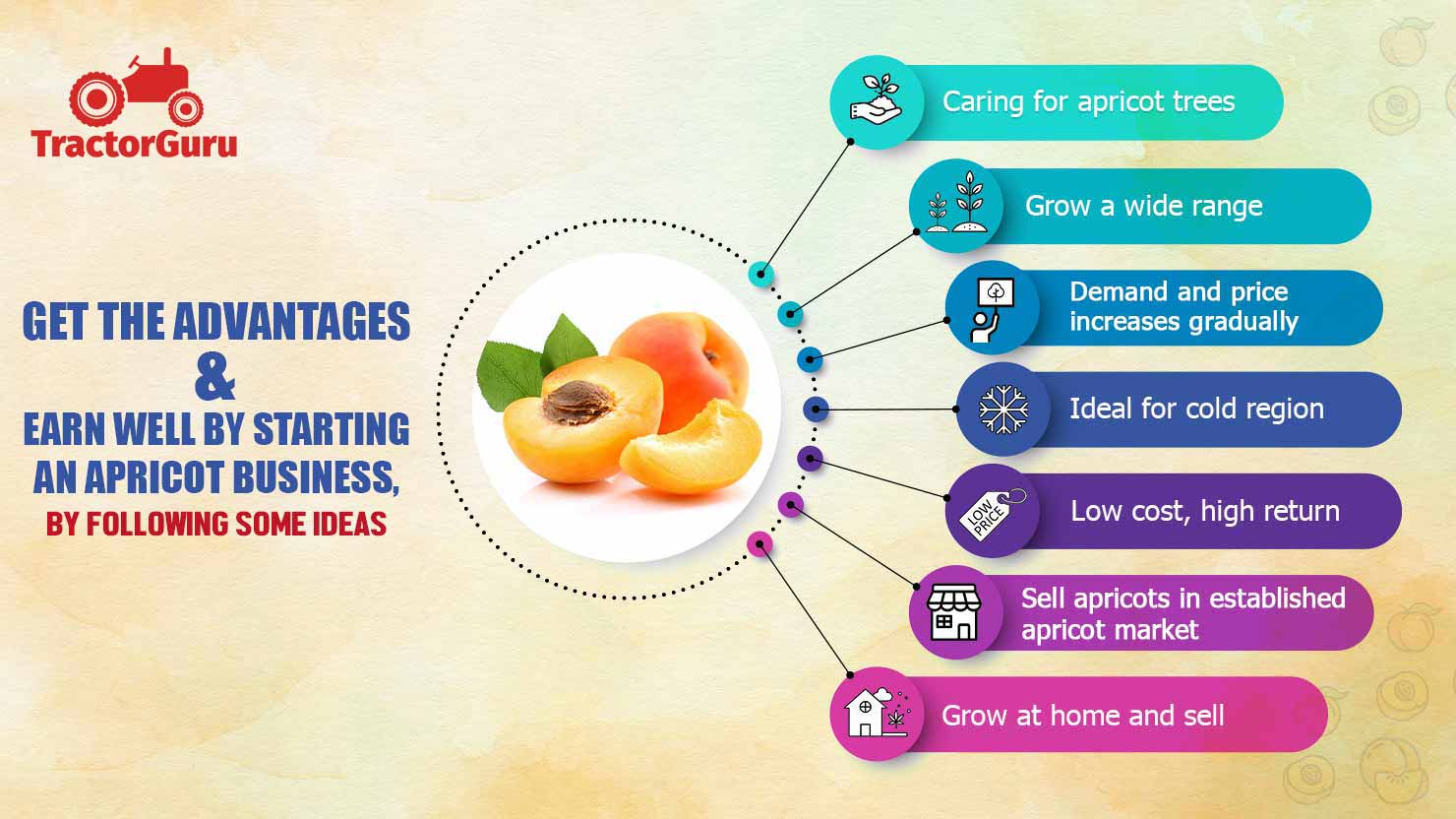
Start a commercial apricot farming business and earn a good profit. Here are some top benefits of starting an apricot fruit farming business that will help you to start this business.
Apricot farming is already a settled business to make profits, and many people are already doing this in many countries. So you can take advantage by taking information or help regarding this business.
Caring for apricot trees can be quite difficult. But with the proper knowledge and information, you can make it easy and start this as a business. So, you can take advantage of this opportunity to earn good profits.
- Apricot fruit is available in many countries around the world because it has an extensive range of cultivation.
- Its demand and price increases gradually. So, you can do apricot cultivation business and make a profit when the time comes.
- Apricot Plants can grow almost everywhere, but the cold region will be ideal for its farming.
- Apricot producing returns are very good, and the cost is also not very high.
- Because of an established apricot market, its marketing is relatively easy. So, you can start this business freely.
- You can start growing apricots yourself and sell them with their healthy uses.
If you are willing to start an apricot business, you must first choose a suitable apricot variety. Check the apricot varieties, which we mentioned below.
How Many Apricot Varieties are Available in India?
Various varieties of apricot are available in India. Following are the popular types of apricots that are mentioned below.
1. Gold Kist
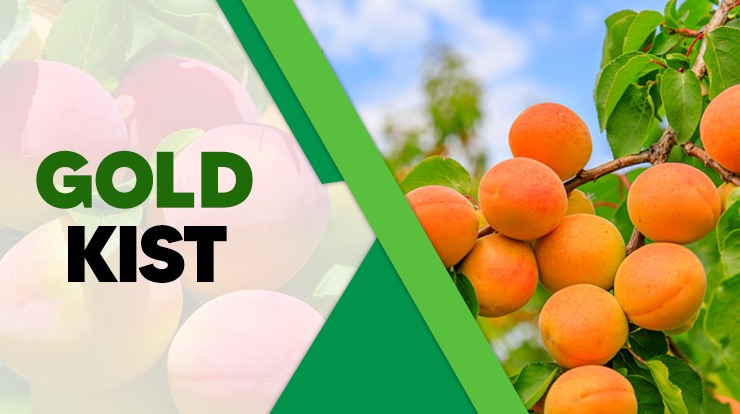
This apricot is medium to large, and the skin is red-blushed yellow. It originated in China. The flavour of this apricot variety is excellent sweet-tart and used for drying, canning, freezing and mainly eating a fresh food. It is an early harvest crop.
2. Goldcot
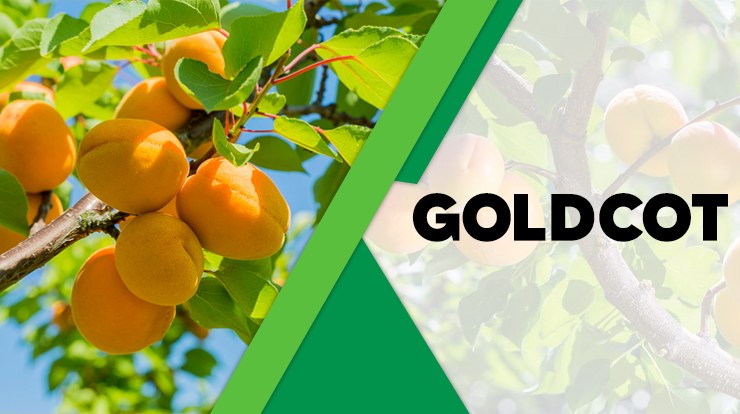
Goldcot is a medium to large fruit variety that is round in shape with bright gold skin. Its thick flesh is orange and sweet-sprightly flavoured. Goldcot originated in Michigan in 1967. This variety is used for canning, processing or eating fresh. It is midseason to late harvest crop.
3. Blenheim
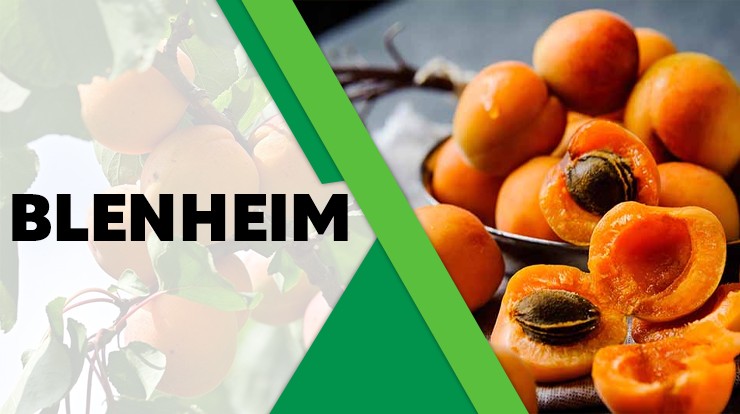
This variety is available with medium to large apricots with thick orange-yellow flesh. These fruits are juicy, aromatic, sweet and sprightly. The Blenheim apricot variety originated in Europe. People also know it as a classic California apricot. You can use it for canning or eating out of hand. It is an early to midseason harvest crop.
4. Rival
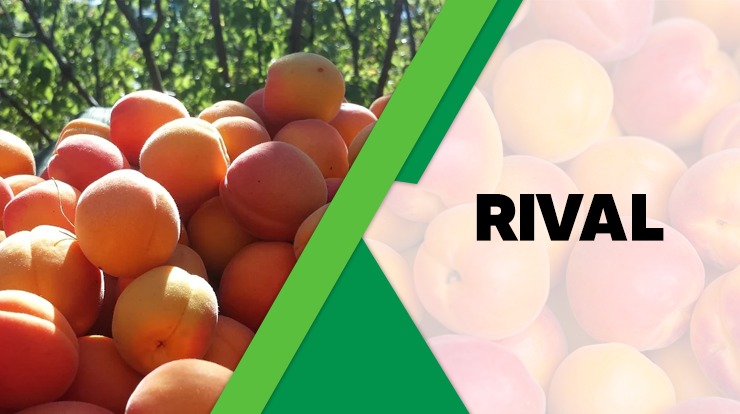
This fruit variety is large, oval orange apricot-blushed red. The fruits are yellow with rosy cheeks and are oval and large. The texture is adorable, and the taste is mild. The origin of the Rival apricot variety in France. Rival varieties require cross-pollination with Goldstrike or Goldbar. It is used in preserving, eating, stewing, and drying. This fruit ripens a week after Goldstrike. It is an early harvested variety.
5. Perfection
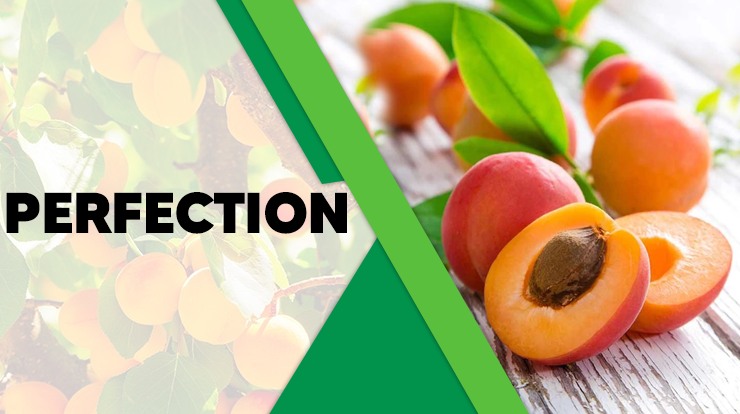
These fruits have oval to oblong, large, light yellow-orange skin with a pebbly appearance. It is yellow to yellow-orange flesh, and it has a mediocre flavour. It originated near the Russian-Chinese border. This crop is early harvested. Perfection is an old variety, and you can get very large fruit, and it ships well. However, it requires pollination and is susceptible to spring frost. Perfection is quite popular, and it lacks flavour.
6. Autumn Royal

These fruits are available with medium to large apricots. This variety is similar to Blenheim but originated in Southern California. The flesh is slightly acidic and yellow. Use fresh, canned, or dried. These fruits are medium with yellow skin with a slight orange blush. It is late harvest into fall.
-
Other Varieties
You can get the large, juicy and good flavorful varieties for the fresh market from Ontario, Harogem, Harlayne and Harglow.
Medium size orange 2E-15-5 apricot that is quite firm, has very good flavour and handles well. When the full colour has developed, then you can pick it. They Mature just before Tilton.
-
Old Varieties
Varieties such as Wenatchee/Moorpark, Skaha, Tilton, and Goldrich are not recommended for commercial planting under current marketing practices.
How to Start Apricot Cultivation in India?
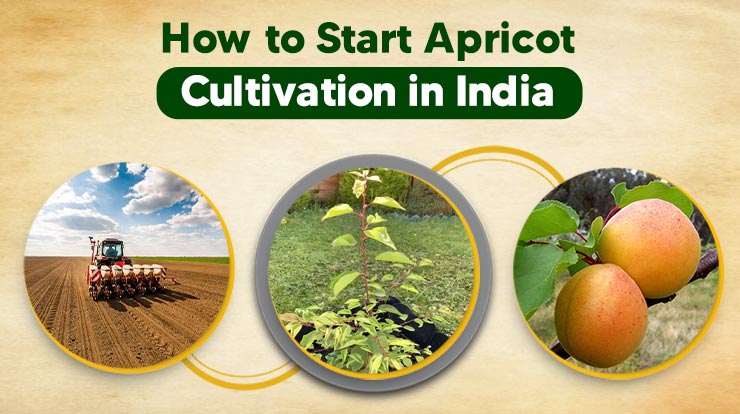
Here in this blog, we are describing more information about apricot cultivation, from planting to harvesting and marketing.
1. Land Preparation
Choose the best apricot farm to grow apricot plants. Fertile and well-draining soil exposed to full sun will benefit apricot cultivation. Soil with good drainage, as apricot plants, do not like moist roots. The correct pH level between 6.7 and 7.5 will be great for growing apricot plants.
2. Climate Requirements for Cultivation of Apricot
Apricot trees require 600 to 900 cool hours every year at a temperature of 0°C to 8°C. Temperatures below 0°C are harmful to these plants. The ideal summer temperature is 37 °C. And their production will be hindered by temperatures above 37 °C.
Farmers should grow red apricots in the sun for a higher yield. Avoid planting them in areas where they accumulate frost. About 100 cm of annual rainfall would be good during the growth period of these plants.
3. Prepare the Soil for Apricot Fruit Cultivation
Before planting the apricot plant, you need to prepare the soil completely. Well-drained, fertile soil is usually good for good plant growth. Dig pits of size 3 x 3 x 3 feet 1 month before planting. Add soil mixture and about 50-60 kg of well-decomposed cow dung in each pit. Also, add 1 kg single super phosphate and 10 ml Chorapyripose solution (10 ml/10 litre of water).
4. Planting of Apricot Fruit in India
Prepare the land impeccably by following the steps mentioned above.
- You should prepare the planting region in early spring.
- Farmers should keep the standard spacing between 20 and 25 feet. The spacing is basically based on a standard apricot tree street height, which can grow anywhere between 20 and 30 feet tall.
- Farmers should Irrigate immediately after planting the small plants. And also, it is always recommended to plant the plants in the afternoon.
5. Caring for Apricot Tree Farm
Apricot plants generally require little care. However, it is very important to take extra care of the plant’s good growth and better production. Taking care of apricot plants is generally easy.
6. Watering For Apricot Farming in India
You require adequate watering for apricot farming, especially during the fruit development phase in April to May. The irrigation frequency depends on the kind of soil, age of the tree and weather conditions. Irrigate at 8 to 10 days intervals during extremely dry and hot periods. Make a good drainage system to avoid water logging in heavy rains.
7. Mulching
Mulching is very significant, especially immediately after planting. It assists in retaining the moisture in the soil but is also supportable to prevent weeds.
8. Controlling Weeds
For apricot production, weed control is very important because weeds consume most of the nutrients from the soil. For weed control, pre-industrial application of Glyphosate 800 ml per hectare or Gramzone 2 litres per hectare and Atrazine or Diuron @ 4 kg per hectare is more effective.
9. Training & Pruning
Apricot trees are trained on a modified centre leader. The 1-year-old whip should be 70 cm above the ground at the back, and at planting time, 4 to 5 well-spaced shoots should be allowed to grow in all directions. Pruning is also necessary to give the tree a good shape. Therefore, pruning should be done in the first dormant season.
10. Pests & Diseases
Apricot plants are susceptible to numerous diseases like other business crops, the relative importance of which varies due to their climatic differences in the major production areas.
For instance, the hot weather experienced in California’s Central Valley often causes pit burn, a condition of brown and soft fruit around the pit. Bacterial diseases include crown gall and bacterial spots. And fungal diseases include brown rot.
The death of branches in summer is attributed to the fungus Utipa creeper. Here examination of the base of the dead branch exhibits a canker surrounding the bite wound.
11. Harvesting
Mostly the fruits of apricot ripen in the first week of May-June, depending on the variety. Trees usually start bearing fruit from the 5th year onwards and reach the maximum fruiting stage at 8 to 10 years. And the trees continue to bear fruit till the age of 35 years. Therefore, you can harvest the fruits manually. However, you should harvest fruits for fresh marketing after the surface colour changes from green to yellow.
Farmers can harvest fully ripe apricot fruits for drying, freezing and canning purposes. However, these fruits are perishable, so utmost care should be taken after harvesting. And grade the fruits based on their size after harvesting, and pack them in wooden or plastic boxes. You can store apricots at 0°C for 1 to 2 weeks while maintaining a relative humidity of 85% to 95%.
Health Benefits of Apricot Fruit
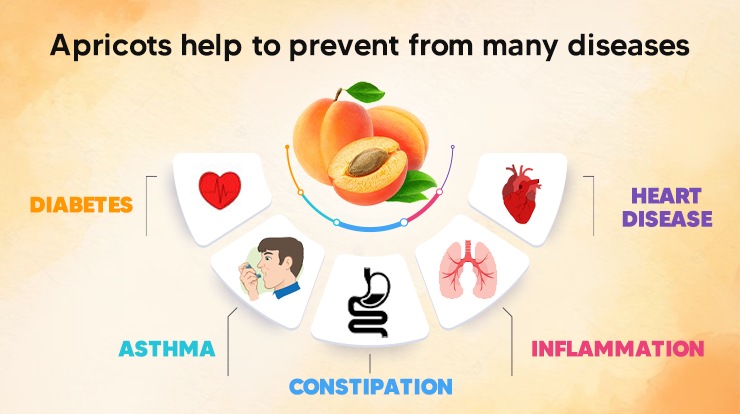
- Apricot is a nutritious fruit. In addition, it is rich in minerals and vitamins. It is low in fat, calories and an excellent source of vitamins A and C. One cup of dried apricots offers 94% of your body’s need for 19% of its iron and Vitamin A.
- One 100 grams of raw apricots supplies 48 calories and comprises 11% carbohydrates, 86% water, 1% protein and less than 1% fat.
- Green apricots come with the same basic nutritional content as ripe fruits; however, they have fewer beneficial pigments and less sugar content producing compounds.
- Two fresh apricots provide the following nutrients. Using apricot for diabetes, asthma, constipation, infertility, and vaginal infections because it is very helpful in these diseases.
- Red apricots are also a good source of an antioxidant, flavonoids that helps to protect against inflammation and inflammatory illnesses and inflammation. Along with this, it reduces the risk for obesity, diabetes, and heart disease. The main flavonoids in apricots are catechin, quercetin, and chlorogenic acids.
Varieties of Apricot in India

This information provides complete knowledge about apricot farming, varieties, advantages and health benefits. We hope this detail will assist you learn how to do apricot farming in India. For more information related to apricot farming and any other farming in India, kindly stay tuned with TractorGuru.
Related Post:



